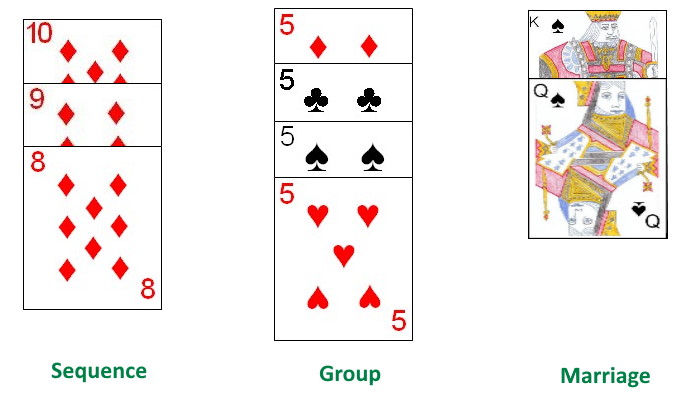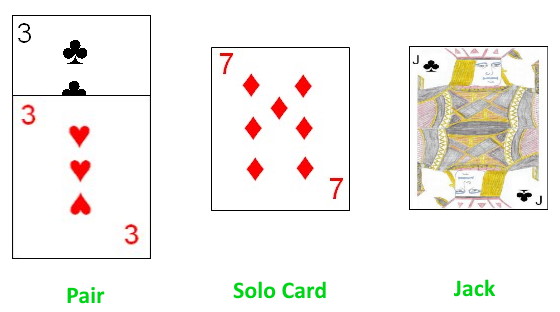How to Play Umtali
Umtali is a fun Rummy type game which was once popular in the African nation of Rhodesia (now known as Zimbabwe). It was often played during railway journeys in that area previous to the 1970's.Umtali is a two player game of the Rummy family and uses one standard 52 card deck. The ranking of the cards (mostly used for purposes of sequential melds) as found in this deck are as follows (from high to low): Ace, King, Queen, Jack, 10, 9, 8, 7, 6, 5, 4, 3, 2.
Determination of seating positions and first dealer can be performed in a variety of ways, with draw for high card a common method. Both players draw a card from the shuffled deck, and the player drawing the higher card has first choice of seat at the table and is also set as the first dealer. If both players draw cards of equal rank, they should each draw an additional card until both players draw non-identical cards. After each hand, the role of dealer should alternate amongst the two players.
Once the players are seated and the dealer determined, this player should thoroughly shuffle the deck and offer it to his opponent to cut. After the cut, the dealer then begins dealing the cards, face-down and one-at-a-time, starting with his opponent. He continues dealing until both players have exactly 10 cards dealt to them. The dealer then deals one more card from the top of the stock to his opponent, such that his opponent has 11 cards and the dealer has 10. The dealer then places the remainder of the stock in the center of the table. This stock pile forms a sort of divider, with each player keeping all his melds on his own side of the draw pile to allow it to be easily distinguished which player made each meld in the game. The non-dealer has the first turn, and thereafter the play alternates amongst the players. On the very first turn of the game, the non-dealer does not draw, but simply reviews his hand, makes any melds he can and wants to make and then selects any card from the 11 in hand and places it on the table next to the stock pile to start a face-up discard pile, ending that turn.
After the first turn, each player starts each turn with a draw. He may either draw the top, face-down card of the draw pile or the top face-up card of the discard pile. If, the player can use the top card as drawn from the discard pile immediately in a meld (at which time the meld is made onto the table), he may also take the second to topmost card in the discard pile if he can also use that card immediately in the same or a different meld (but must also make that meld immediately to the table).
 After the draw, a player must then make any available melds from his hand to the table. Note that players are obligated to make any available melds to the table from the hand, if able. There are several meld types in Umtali which can be formed:
After the draw, a player must then make any available melds from his hand to the table. Note that players are obligated to make any available melds to the table from the hand, if able. There are several meld types in Umtali which can be formed:
- Sequence: A sequence meld is a series of three or more cards in direct sequential order and all of the same suit (such as 8, 9 and 10 of Diamonds). Note that in this game the Ace is considered low and if used in a sequence meld may only be played in such a sequence immediately before a 2 of the same suit. In the initial melding of a sequence, that sequence can never contain any Jacks.
- Group: A group or set is a meld consisting of three or four cards all of the exact same rank, of any denomination, save Jacks.
- Marriage: A marriage meld is a meld consisting of the King and Queen of the same suit.
In addition to these three standard types of melds, there are several special types of melds which can be made during the game, but usually limited to certain circumstances during the game.

- Pair: A pair is exactly two cards of the same rank. This meld type is limited and may only be the last meld a player makes on depleting his hand to win the hand.
- Solo Card: A solo card meld is a meld consisting of one single card. In most circumstances this is a card played which will extend an existing meld which has already been played to the table. These single card extensions of a meld can be made to a player's own meld or to his opponent's meld. Solo card melds are not added to that existing meld, however, but instead are simply played to the table, face-up on the table in that players half of the table. The player should also state which meld he is extending in playing a solo card meld. Note that these melds can further be extended by either player. Note that if a specific card or cards in that player's hand can be used in a solo card meld or in a sequence, group or marriage he must opt to play the card in the multi-card meld rather than the solo card meld.
- Jack: The four Jacks in the deck are special cards. They may never be melded in an initial meld as part of a new Sequence or Group. They may only be played as single card melds. Thus, a Jack could be used to extend an existing meld, as able. A Jack, even just one, is always a legal meld and can simply be played to the table on a player's turn. A single Jack meld on the table may be extended by other players, adding cards to form sequences from this Jack (i.e. building upward with a Queen or building downward with a ten) or adding further Jacks to form a group.
Winning the Hand and Scoring: The game continues with the players alternating turns until one player manages to deplete his hand. As mentioned previously, he may do this by playing the last of his cards to the table in legal melds. Alternatively, he may play all but one of his cards to the table in legal melds (including a Pair meld on his last turn) and then discard his last card from his hand to the discard pile. In discarding his last card the player has the option to discard that last card face-down on the top of the discard pile. Once a player manages to fully deplete his hand, his opponent has one more full turn in which he can draw, make any legal melds, and then discard. If the player who managed to deplete his hand played his last discard face-down, this player, on his last turn may not draw that card and must instead draw from the draw pile. If this player does not manage to also deplete his hand during this last turn, any unplayed cards remaining in his hand are scored for the player who managed to deplete his hand during the hand. Each player also earns points for each card successfully melded to the table. Each card in the deck has a specific point value which is added to the melding players ongoing, cumulative score, which is shown in the following chart:
| Card | Point Value |
|---|---|
| King, Queen, Jack, 10 | 5 Points Each |
| Ace, 2, 3, 4, 5, 6, 7, 8, 9 | 1 Point Each |
Cards which form part of a Marriage meld score double.
A game of Umtali consists of exactly four hands. After four hands, the players compare the accumulated points earned during the four hands and the player with the higher total is declared the winner of the game. Umtali is often played in sessions, with each session comprised of three games. Whichever player first wins two games is declared the winner of the session.